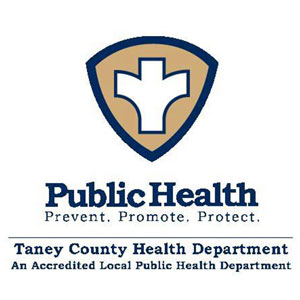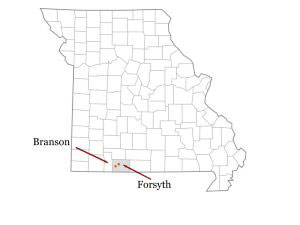Dec 18, 2019
Taney County Health Department: Accreditation and Holding to a Higher Standard
Related Articles
It's
Possible: Voluntary Accreditation for Rural Public Health
Departments
Understanding
Rural Health Departments: Do They Have Unique
Accreditation Needs?
 Lisa Marshall is
the director of Missouri's Taney County Health
Department (TCHD), a local health department that has
offices in both Forsyth and Branson. It serves a
micropolitan county population of around 55,000 and is
governed by a local elected board. The department has 35
employees and Marshall said they all wear multiple hats.
Lisa Marshall is
the director of Missouri's Taney County Health
Department (TCHD), a local health department that has
offices in both Forsyth and Branson. It serves a
micropolitan county population of around 55,000 and is
governed by a local elected board. The department has 35
employees and Marshall said they all wear multiple hats.
 "Because of its overuse, I'm
shy about using the word 'unique,' but I don't know how
else to describe our health department,"
Marshall explained. "We're small. But because
our county is home to a large tourism, recreation, and
hospitality industry, we have 8 million visitors a year.
Eight million visitors to one rural area is unique. As a
public health department, that means we are always
flexing our work to meet the needs of our county
population and our visitors. Accreditation
provides that external standard that drives us to
continually use quality assurance and quality improvement
processes to better to do our work."
"Because of its overuse, I'm
shy about using the word 'unique,' but I don't know how
else to describe our health department,"
Marshall explained. "We're small. But because
our county is home to a large tourism, recreation, and
hospitality industry, we have 8 million visitors a year.
Eight million visitors to one rural area is unique. As a
public health department, that means we are always
flexing our work to meet the needs of our county
population and our visitors. Accreditation
provides that external standard that drives us to
continually use quality assurance and quality improvement
processes to better to do our work."
Prior to the existence of a national accreditation program, Marshall said that the department had been accredited by the state's voluntary program, MICH, or the Missouri Institute for Community Health, an accreditation offering that began in 2003. Marshall said that because TCHD was an early adopter of that accreditation, when national standards came into existence with the Public Health Board of Accreditation (PHAB), the TCHD board and department leaders decided that national voluntary accreditation was also important. In 2015, TCHD was one of the first 100 departments in the nation to achieve PHAB accreditation.
Marshall reviewed TCHD's public health work. Of importance is that seasonal employment impacts health department services due to low wage jobs that usually don't provide health insurance benefits. TCHD bridges that gap when able. In addition to clinical services, like immunizations and family planning, she explained that their Community Outreach is very active as is the department's Environmental Health Service teams. The latter is driven by the associated needs that come with 8 million visitors a year. According to TCHD's 2018 annual report, that team alone completed nearly 1,900 facility inspections.

"Our environmental health work is quite a large percentage of what we do," Marshall said. "We have a very robust team because we have so many restaurants and lodging facilities. In Branson alone, we have more lodging facilities than any other county in our state. Because we work with that volume, we are a 'go-to' source when other health departments are looking for how to go about those processes or to scale-up when infection outbreaks occur."
During initial accreditation efforts, Marshall was a Community Development Specialist with TCHD, but she provided a look-back perspective on some of their challenges during those activities and compared them with current reaccreditation efforts. She said that one of the easier challenges was actually the decision to attempt PHAB accreditation.
"What I've heard from our staff is that our board and our department has always had a focus on holding to a higher standard," she said. "We've been MICH accredited probably as long as it's been offered and our department was one of the first accredited by that state standard. Historically speaking, then, I think that it was somewhat of an easy decision at the leadership level to be accredited by national standards when PHAB was created. That national accreditation seemed to be identified as the next step to upping our department standards in order to provide the best service we can to our clients."
Accreditation and Public Health Evidence-Based Practices and Programs
Marshall pointed out that because of MICH, TCHD staff were already champions of public health evidence-based decision-making and programming that would be needed for PHAB accreditation. One evidence-based program the department uses is TOP, or Teen Outreach Program, a program that "promotes the positive development of adolescents through curriculum-guided, interactive group discussions; positive adult guidance and support; and community service learning." Experts said that evidence-based public health practices are core to accreditation and more examples can be found on the websites of the Association of State and Territory Health Officials, the Centers for Disease Control and Prevention, and the National Association of County & City Health Officials.
Now that TCHD is undertaking PHAB
reaccreditation. Marshall said new challenges
have emerged that are providing opportunities to
"stretch." Two specific examples are
operational funding decreases and attrition of key team
members previously associated with initial accreditation.
She pointed out that funding and staffing are challenges
that many rural health departments encounter every day
and she offered several tips to help with accreditation
efforts in these situations.
"First, don't be intimidated," she said. "Read that accreditation packet. If you feel overwhelmed, go ahead and walk away from it for a while, but don't be afraid to pick it up and read it again. If you still think it's too much effort, just think about that saying about how to eat an elephant. You can get through that accreditation packet one domain at a time."
She also offered an approach her department is using now as they proceed through the reaccreditation process without the people who assisted with the original accreditation. Acknowledging this institutional knowledge gap, Marshall said the leadership team and the accreditation coordinator sat down, reviewed the standards, and had the 'aha' moment.
"We asked ourselves, 'Who holds the keys to these pieces?'" Marshall said. "We realized that we just needed to empower our staff. We've told them, 'This is what you do every day. You know it best. Run with it.' We're learning we can lean on our staff's expertise, let them shine where they are already providing excellent service. It's giving us a better end product. And we are seeing huge personal growth. Staff are getting affirmation from showcasing their best-practice work during this reaccreditation process. It's empowering and it's validating for our staff. There's no reason this can't work for an initial accreditation effort, too."

